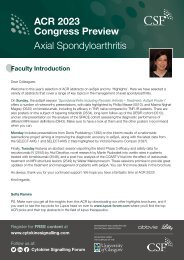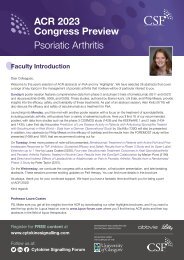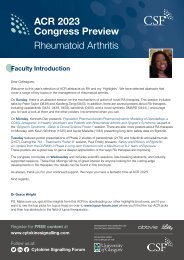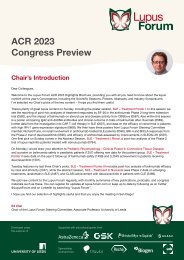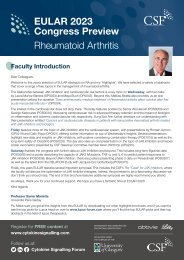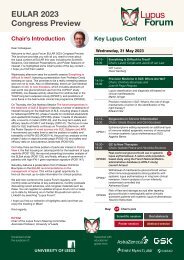ACR Congress Review 2019
Create successful ePaper yourself
Turn your PDF publications into a flip-book with our unique Google optimized e-Paper software.
Individual and composite measures of disease activity in patients with RA treated with upadacitinib or<br />
comparators were presented by van Vollenhoven and colleagues. The analyses included patients who<br />
were MTX naïve (SELECT-EARLY, n=947) or MTX-IR (SELECT-COMPARE, n=1629). Responses at<br />
Week 12 were defined as ≥50% improvement in the 7 components of the <strong>ACR</strong> response criteria. In<br />
MTX-naïve and MTX-IR patients, treatment responses at 12 weeks occurred in significantly higher<br />
proportions of patients receiving upadacitinib monotherapy versus MTX and upadacitinib plus MTX<br />
versus placebo for all 7 components of the <strong>ACR</strong> response criteria, and for 5 of 7 <strong>ACR</strong> components for<br />
upadacitinib plus MTX versus adalimumab plus MTX. Favourable outcomes with upadacitinib treatment<br />
were evident both in composite and individual parameters [523].<br />
Kremer and colleagues presented the comparative efficacy of upadacitinib in combination with MTX<br />
versus upadacitinib in combination with other csDMARDs. Analyses were performed using data from the<br />
SELECT-NEXT and SELECT-BEYOND trials, in which 535 and 410 patients, respectively, received<br />
concomitant MTX (mean dose 17 mg/week), and 124 and 82 patients received non-MTX csDMARDs.<br />
Across all subgroups, the proportion of patients achieving efficacy outcomes was higher with both<br />
upadacitinib doses compared with placebo. There were no significant differences between efficacy<br />
outcomes with upadacitinib in combination with MTX versus upadacitinib in combination with non-MTX<br />
csDMARDs in either patient population; this included <strong>ACR</strong>20 response as well as LDA and remission<br />
defined by DAS28-CRP and CDAI. In summary, the efficacy of upadacitinib in patients with RA<br />
appeared comparable whether administered in combination with MTX or non-MTX csDMARDs [524*].<br />
Hall and colleagues presented remission rates in patients with RA treated with upadacitinib or<br />
comparators. The analyses included patients who were MTX naïve (SELECT-EARLY, n=945), MTX-IR<br />
(SELECT-COMPARE, n=1629) and bDMARD-IR (SELECT-BEYOND, n=498). At 12 weeks, in<br />
SELECT-EARLY and SELECT-COMPARE, a significantly greater proportion of patients receiving<br />
upadacitinib 15 or 30 mg QD achieved remission by all four definitions versus MTX, placebo or<br />
adalimumab. In SELECT-BEYOND, (a refractory population many of whom had an inadequate response<br />
to multiple bDMARDs), a significantly greater proportion of patients receiving upadacitinib 30 mg<br />
achieved all remission definitions versus placebo within the first 12 weeks and rates of remission further<br />
increased through Week 24 for both dose groups. All disease activity components of each remission<br />
definition were significantly improved in patients receiving upadacitinib compared to MTX or placebo,<br />
and all Boolean components were significantly improved in patients receiving upadacitinib 15 mg<br />
compared with adalimumab [529].<br />
An evaluation of structural joint damage progression through Week 48 in patients with moderately to<br />
severely active RA treated with upadacitinib monotherapy or in combination with MTX was presented by<br />
Peterfy and colleagues. The analysis included patients from SELECT-EARLY (n=945) and<br />
SELECT-COMPARE (n=1629). At Weeks 24/26, upadacitinib as monotherapy and in combination with<br />
background MTX significantly inhibited radiographic progression (measured by mean ΔmTSS) and the<br />
proportion of patients with no radiographic progression versus MTX and placebo, respectively. The<br />
significant inhibition of radiographic progression with upadacitinib was maintained through Week 48<br />
versus MTX in SELECT-EARLY and versus placebo in SELECT-COMPARE. Following the switch of all<br />
placebo patients to upadacitinib in SELECT-COMPARE by Week 26, no further change in mean mTSS<br />
was observed through Week 48. In summary, upadacitinib both as monotherapy, and in combination<br />
with background MTX, was effective in inhibiting the progression of structural joint damage through<br />
Week 48 in MTX-naïve, and MTX-IR patients, respectively [547*].<br />
Fleischmann and colleagues presented outcomes associated with a treatment switch from upadacitinib<br />
to adalimumab and vice-versa among MTX-IR RA patients who were non-responders or partial<br />
responders in a Phase 3 study of upadacitinib 15 mg QD versus placebo or adalimumab 40 mg injection<br />
EOW. Of the 651 and 327 patients randomised to receive upadacitinib and adalimumab, 39% were<br />
switched from upadacitinib to adalimumab and 49% were switched from adalimumab to upadacitinib.<br />
*Chairman’s Pick



